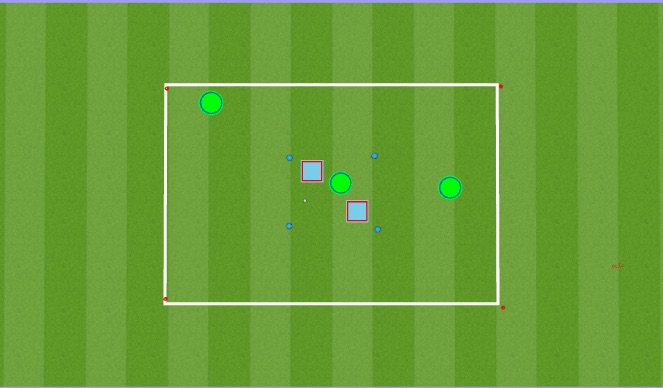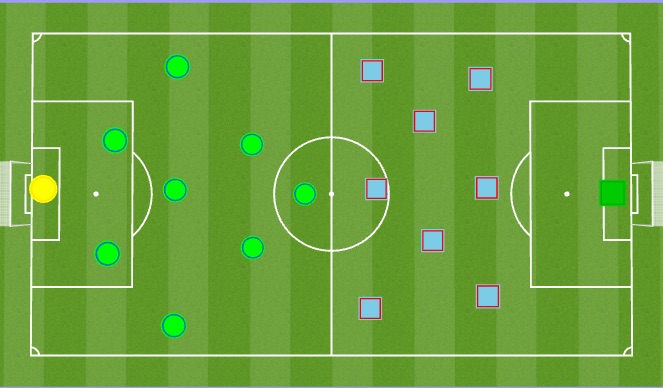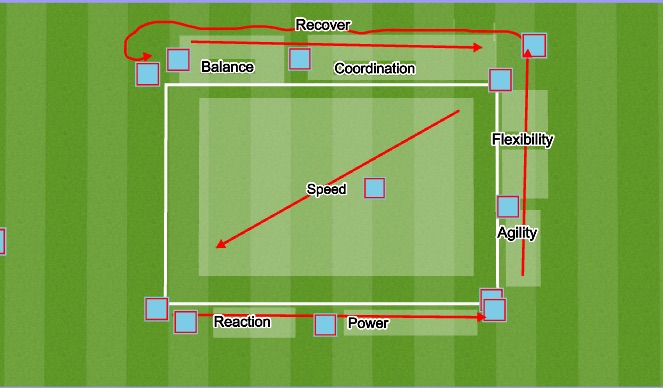Football/Soccer Session (Moderate): Transition Combo - Counter Press and Connect Out

Profile Summary

| Name: | David Zook |
|---|---|
| City: | Phoenix |
| Country: | United States of America |
| Membership: | Adult Member |
| Sport: | Football/Soccer |
Description
This session combines the complementary transition topics of Counter Pressing and Connecting Out

See the guidance at the top of this page to understand why you are not seeing interactive Football/Soccer images.

Group Game: Across the River (10 mins)
Game Objective: Disrupt the pass in the endzone
Topic: Protect the Space Behind the Backline
Phase: Collectively Defend
Problem: There is space behind the backline.
Who: 4,5, 2, 3 primarily; 6, 8, 10 secondarily
Where: Middle to Back Third
When: the opponents play ball behind the line
What: Anticipate; Eyes on ball; Drop as my man moves toward goal
Why: Prevent playing into space
Layout: 40 x 50; two goals
Restrictions: 4v4v4; Two touch; 3:8:1
Scoring: One point for each pass disruption in endzone.
Game: Play to opposite endzone; when pass is disrupted in the endzone, the attacking receiving team moves to the middle; the recovering team must connect out before playing forward.
Coaching Points: (1) ANTICIPATE pass and DROP in space. (2) COVER position (3) EYES toward pass (4) KEEP pace with opponent.

See the guidance at the top of this page to understand why you are not seeing interactive Football/Soccer images.

The Box Game

See the guidance at the top of this page to understand why you are not seeing interactive Football/Soccer images.

Final Game
Game Objective: To create space for the attacker in order for him to have time and space to shoot
Topic: Separate From the Defender
Phase: Finishing
Problem: Defenders are too close to us.
Who: 8,9,10
Where: Final Third
When: As the ball is being released
What: Attackers without the ball accelerate on a diagonal run to create space or drift away from the defender to create space
Why: to open enough space to shoot
Layout: 40 x 40; 2 goals
Restrictions: 9v 9; 4-3-1; 3-2-3 10:2:1
Scoring: one point for correct run and one point for each score
Game: Regular Game
Coaching Points: Time your runs to stay onsides. If the 4 and 5 are both looking at the BC, the other two need to drift away laterally from them to create space. When receiving ball make sure hips are parallel with the goal.









 Play animation
Play animation Play step-by-step
Play step-by-step Repeat (toggle)
Repeat (toggle) Full Screen
Full Screen Pause
Pause Stop
Stop
Fitness Warm Up
There are seven skills stations designed to improve the player's athleticism.
Any of these can be done solo, in pairs to make it competitive, and with or without the ball. For ideas on activities for each skill, go to YouTube, there is plenty there. Vary the activity each session to keep it engaging and challenging. Be sure to work the mind and both the right and left side of the body. Grid size varies with a minimum of 20X20 for older players and 15x15 for younger players.
The continuous nature of the circuit builds endurance. Build to a single 12 minute period for older players and 8 for younger. In the beginning, if you need to break into multiple periods of three or four minutes per period, then do so.
For younger kids, you could have a circuit of 3 or 4 of these skills one session and the rest of them in the next session.
Here are the seven skills:
1. BALANCE: the ability to control or stabilize the body when a person is standing still or moving.
2. COORDINATION: the ability to use the senses together with body parts during movement.
3. SPEED: the ability to move your body or parts of your body swiftly.
4. REACTION: the ability to move the body parts swiftly while applying the maximum force of the muscles.
5. POWER: the ability to reach or respond quickly to what you hear, see, or feel.
6. AGILITY: the ability to change and control the direction and position of the body while maintaining a constant, rapid motion.
7. FLEXIBILITY: the ability to move joints or groups of joints effectively through a complete range of motion that includes stretching to lengthen the muscles